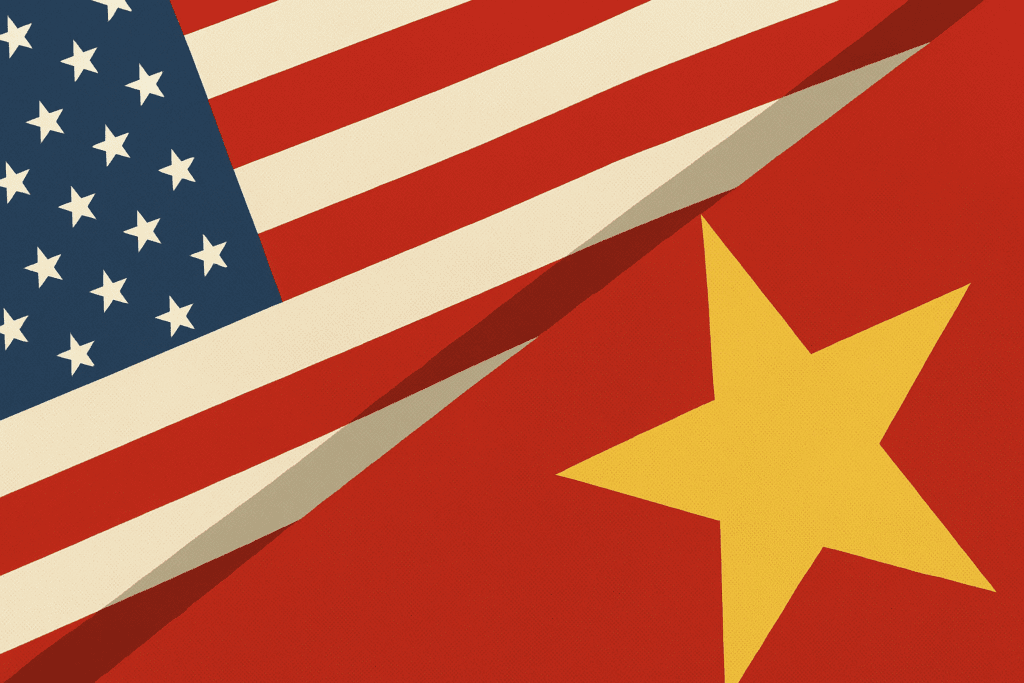At Vietnam Sourcing Co., we recognize the importance of timely, accurate information, especially when it concerns trade policies that could reshape manufacturing, investment, and supply chain strategies in Vietnam. While this announcement has yet to be verified through official diplomatic channels, it merits close examination.
Breaking Down the US–Vietnam Trade Terms
According to Mr. Trump’s statement, the deal includes the following terms:
- Vietnam will apply a 20% tariff on U.S. imports, and a 40% tariff on transshipped goods.
- In return, the United States will offer “total market access” to Vietnamese goods, imposing 0% tariffs on all imports from Vietnam.
- He also suggested that SUVs and large engine vehicles would be a strong addition to the Vietnamese market.
These claims have raised immediate questions around feasibility, legality, and international precedent.

Key Issues to Consider
1. Tariff Imbalance and Trade Agreement Structure
Modern Free Trade Agreements (FTAs) such as the CPTPP, EVFTA, and RCEP are built on the principle of reciprocity, aiming for balanced reductions in trade barriers on both sides. A proposed structure with asymmetrical tariffs (20–40% vs. 0%) contradicts the foundational norms of such agreements and would likely conflict with Vietnam’s current trade commitments.
2. Lack of Official Confirmation
Bilateral trade deals require a rigorous negotiation and ratification process, involving relevant ministries and legislative bodies in both countries. So far, there has been no confirmation from Vietnam’s Ministry of Industry and Trade, the U.S. Department of Commerce, or any other credible agency, calling into question the legitimacy of the statement.
3. The Context of General Secretary To Lam
While To Lam currently holds the position of General Secretary, the idea that such a detailed trade agreement could be finalized and publicly announced based solely on a private discussion remains highly unconventional and unprecedented.
Beyond the Headline: What It Signals for US-Vietnam Trade
Despite the lack of official backing, the mention of Vietnam in such a high-profile context is noteworthy and reflects several key underlying trends:
Vietnam’s Rising Strategic Importance
Vietnam’s growing presence in global supply chains and its reputation as a manufacturing hub are increasingly recognized. That it was singled out in a major U.S. political statement highlights its importance in shaping the future of global trade.
Momentum for Market Access and Growth
Even speculative discussion of expanded market access between Vietnam and the U.S. reinforces the potential for increased exports and diversified trade. Were a zero-tariff scenario to emerge in any credible form, it could unlock substantial value for Vietnam’s key export sectors.
Opportunity in the Automotive Sector
Trump’s reference to SUVs and large engine vehicles suggests potential future demand in Vietnam’s automotive sector. This could translate into expanded opportunities for local assembly, foreign investment, and supply chain development in the automotive and mobility industries.
Strengthening FDI Sentiment
Announcements—even unverified ones—that hint at deeper cooperation between major economies can boost investor confidence. Companies reevaluating their supply chains due to geopolitical risks may see Vietnam as a more attractive, stable option in the long term.
What Should Businesses Do Now?
While the current claim should be treated with caution, it is a timely reminder that trade policies are evolving—and sometimes unpredictable. Businesses should consider the following:
- Monitor official trade announcements from both governments and multilateral bodies.
- Review sourcing strategies for flexibility and resilience against sudden policy shifts.
- Engage with expert partners in Vietnam who understand the local policy landscape and can help navigate uncertainty.
Conclusion
Whether or not this proposed “deal” becomes reality, it reinforces the urgency for businesses to stay agile and well-informed. At Vietnam Sourcing Co., we’ll continue to monitor the situation and provide insights to help our partners make proactive, confident decisions.
If you’re currently sourcing from Vietnam or considering it now is the time to evaluate your strategy and explore potential trade developments with expert guidance.

